NRAO eNews
Volume Vol#, Issue Iss#
Day# Month# Year#
NRAO eNews
Volume Vol#, Issue Iss# • Day# Month# Year#

Upcoming Events

ALMA2019: Science Results and Cross-Facility Synergies
Oct 14 - 18, 2019 | Cagliari, Sardinia, Italy

Jansky Lecture: Dr. Anneila Sargent
Dec 5, 2019 | Charlottesville, VA

Breakthrough Science with the Atacama Large Millimeter/submillimeter Array
Jan 6, 2020 | Honolulu, HI

The Scientific Quest for High Angular Resolution
Jan 7, 2020 | Honolulu, HI

NRAO Town Hall
Jan 7, 2020 | Honolulu, HI

Detecting Extraterrestrial Technologies and Life
Feb 15, 2020 | Seattle, WA

35th New Mexico Symposium
Feb 21, 2020 | Socorro, NM

Jansky Lecture: Dr. Anneila Sargent
Feb 21, 2020 | Socorro, NM

Compact Objects and Energetic Phenomena in the Multi-Messenger Era
Jul 14 - 16, 2020 | Saint Paul, MN
Major NSF Funding Awards for ngVLA & GBO
Additional ngVLA Design & Development Funding
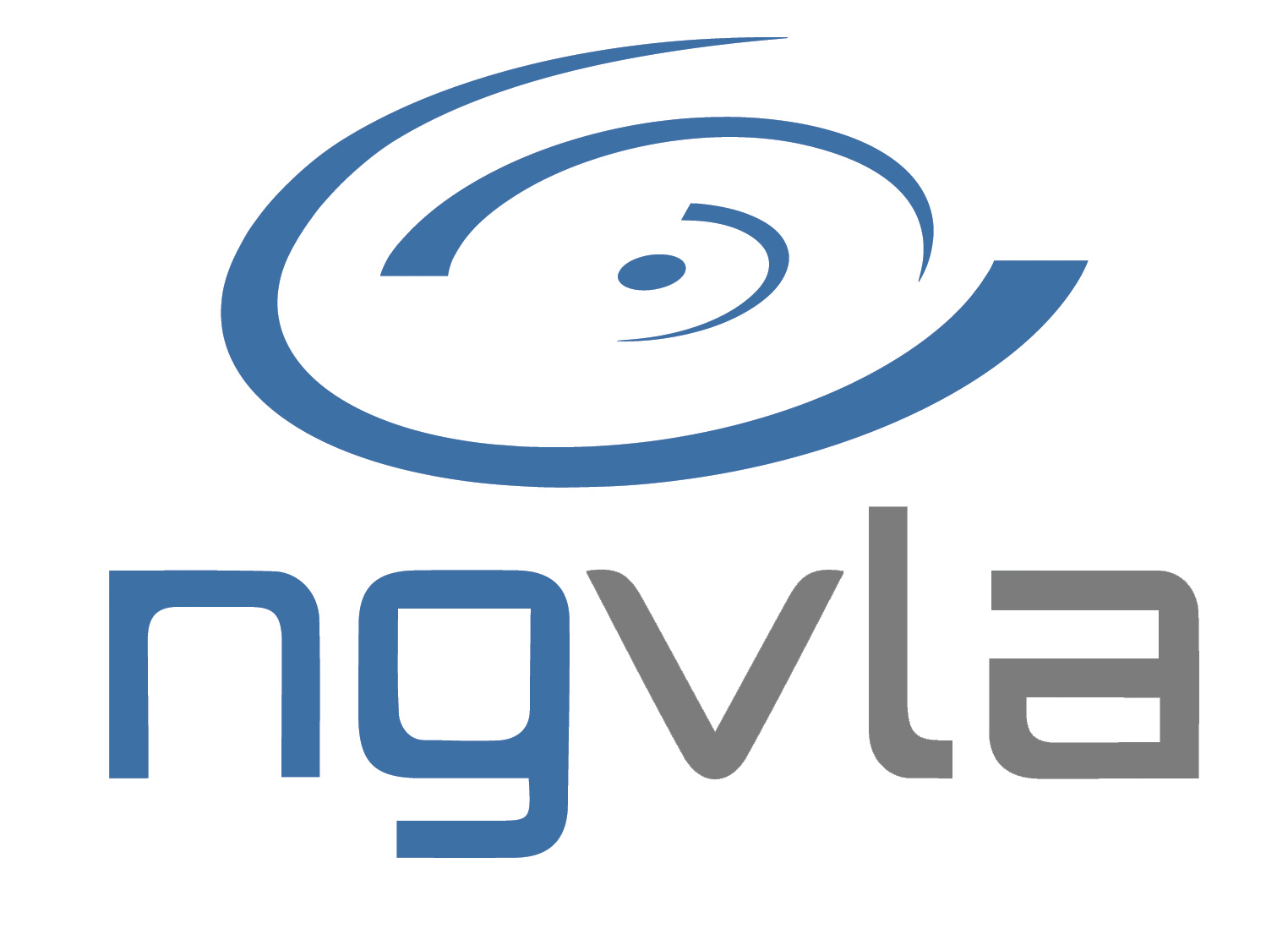
I am pleased to convey the excellent news that the National Science Foundation (NSF) has awarded NRAO / AUI an additional $4M of design & development funding for the next generation Very Large Array (ngVLA) to initiate activities in Fiscal Year 2020. Please join me in congratulating ngVLA Project Director Mark McKinnon, Project Scientist Eric Murphy, Project Engineer Rob Selina, the project team, and the countless members of the astronomical community who have helped shape the ngVLA concept for their achievement of this important milestone. As you understand, NRAO is currently refining the ngVLA design and delivering key information regarding the ngVLA reference design to the U.S. Astro2020 Decadal Survey process for review.
Importantly, with this $4M funding increment, NSF has created a cooperative support agreement specifically for ngVLA. Such agreements are long-term funding arrangements, put in place to support existing facilities and key activities. This new funding will continue the efforts of the ngVLA Project Office as we prepare for a submission to the Major Research Equipment and Facilities program within the next two years.
These ngVLA successes derive from the dedication of the staff, the interests and active participation of the scientific and engineering communities, and Associated Universities, Inc. support. There is plenty to do, and our future looks bright. Additional information regarding this ngVLA design & development award is described in a NRAO news release.
New Green Bank Observatory Five-Year Cooperative Agreement
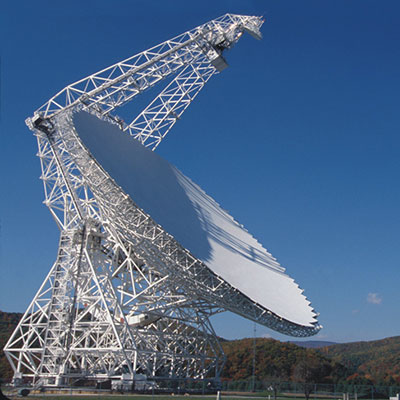
The NSF also recently announced a new five-year Cooperative Agreement with Associated Universities, Inc. to manage the Green Bank Observatory (GBO). This funding award provides new stability and a path to further growth of the GBO and the Green Bank Telescope in coming years after several years of uncertainty associated with the 2012 Portfolio Review.
Congratulations to GBO Director Dr. Karen O’Neil and the entire Green Bank team on this important outcome! The National Science Foundation Director, Dr. France A. Córdova, visited Green Bank to help celebrate the award, and met with the GBO staff.
Additional information regarding Green Bank and this new NSF-AUI Cooperative Agreement is described in a GBO news release.
ngVLA Project News
Tenure-Track Astronomer Position Focused on ngVLA Key Science
The NRAO is seeking to appoint a tenure-track scientist in the area of next generation Very Large Array (ngVLA) Key Science. The appointee will be expected to contribute to the science relevant to the ngVLA, including identifying and developing future scientific priorities for ngVLA and the NRAO, and building support for those priorities within the U.S. and international astronomy communities. Interested parties should visit the job posting page for more details on the job description and instructions on how to apply. The application window closes 31 October 2019.
First International ngVLA Science Conference
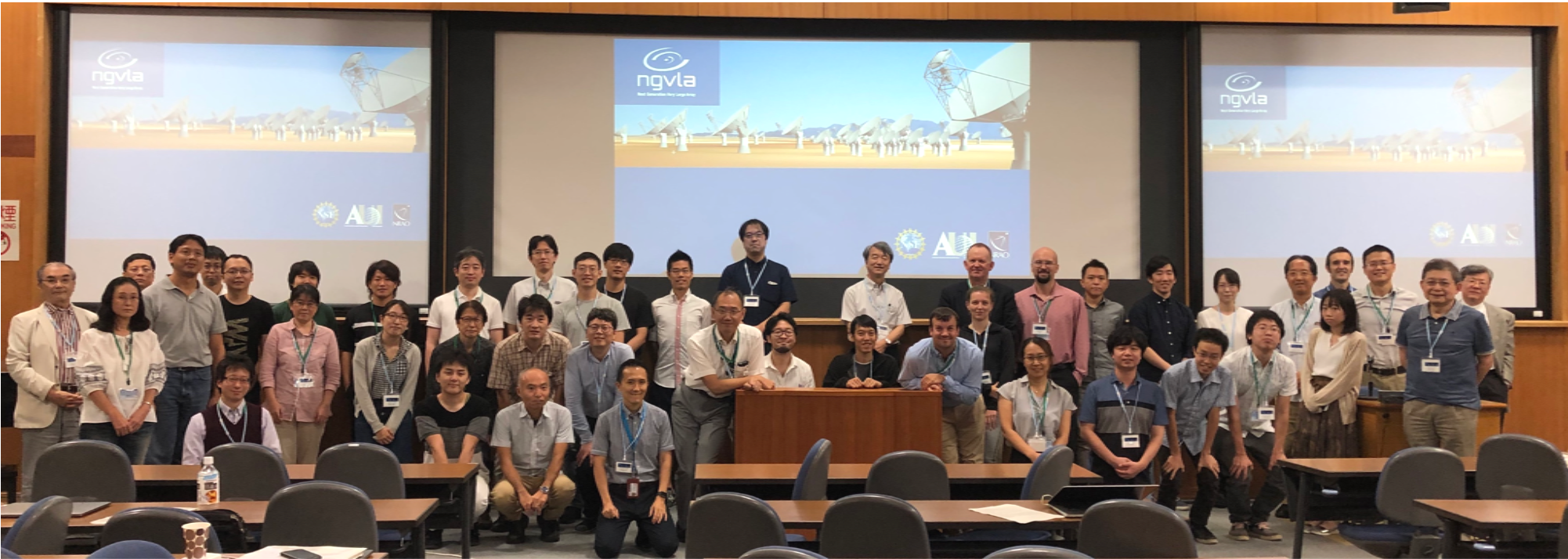
The National Astronomical Observatory of Japan (NAOJ) has recently launched a dedicated ngVLA study group, including external members, to pave the way for the eventual Japanese participation in this project, which would grant access to ngVLA observing time for the Japanese community. As seen in the Key Science goals defined by the U.S. science community, ngVLA is highly complementary with the ongoing science of the Atacama Large Millimeter/submillimeter Array (ALMA), and access to both facilities would offer the opportunity for the Japanese community to continue producing ground-breaking science results in the coming decades.
To explore the Japanese community interest, a meeting was held 17-20 September at NAOJ in Mitaka to inform the community about the status of the ngVLA project and to discuss and identify new science enabled by participating in ngVLA, through a series of invited and contributed talks by our community members. This marks the first international ngVLA Science Conference! The meeting was very successful, hosting ~100 participants, half of whom were students/early career. Thirty-six talks were presented during the conference, all of which will be made available on the conference website. The wide breadth of science covered in these presentations clearly indicated a high degree of enthusiasm and interest in the ngVLA project, and will help set the stage as the Japanese community begins to write their own ngVLA Science Book.
The Scientific Quest for High Angular Resolution
On 7 January 2020, the NRAO and the ngVLA Project will convene a Special Session on The Scientific Quest for High Angular Resolution at the American Astronomical Society winter meeting in Honolulu, Hawaii. This Special Session will highlight recent scientific breakthroughs enabled by imaging at high angular resolution. It will feature a session of invited oral presentations from 2:00 - 3:30 p.m. local time, plus an associated day-long poster session with contributed presentations. Submissions of poster abstracts have closed. In the coming weeks, Joan Wrobel will connect with poster presenters to offer ngVLA-themed templates and assistance with printing and shipping.
Compact Objects and Energetic Phenomena in the Multi-Messenger Era
On 14-16 July 2020, the NRAO and the ngVLA Project will convene a science conference titled Compact Objects and Energetic Phenomena in the Multi-Messenger Era in Saint Paul, Minnesota, USA. Pre-registration is open. SOC co-chairs are Nicole Lloyd-Ronning (LANL) and Tom Maccarone (Texas Tech University). A diverse and exciting group of invited speakers has been announced.
Registration and Abstract submission will open on December 1.
ALMA Program News
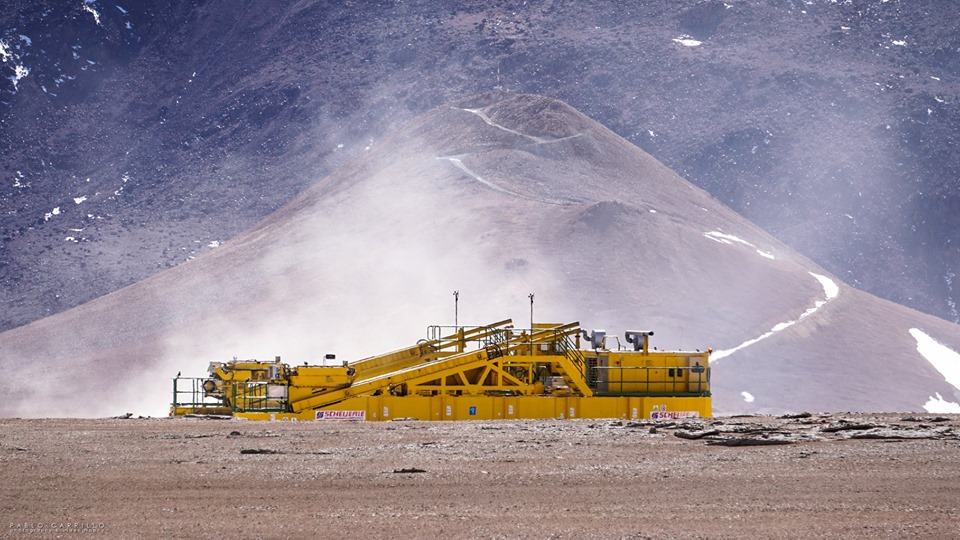
Pablo Carrillo
ALMA's Transporter Lore heads for an antenna to carry to a new location. Spring brought a surprise snowfall to the 5000m Array Operations Site (AOS) as Cycle 6 drew to a close.
[click to enlarge]
Cycle 7 Time Allocation
On 1 October 2019, the new observing cycle (7) began at ALMA with the array in configuration C43-4 (0.78 km maximum baseline, 100 GHz beam 1.0 arcsec). The 4300 hours planned for a Cycle in Full Operations have been awarded in Cycle 7; 4000 hours were awarded in Cycle 6. Details may be found at the ALMA Science Portal. The array will gradually move to shorter baselines over the next few months, ending October in the C43-3 configuration. We note that ALMA achieved its first fringes with two antennas at the Array Operations Site (AOS) on 21 October 2009, only ten years ago.
Cycle 7 Supplemental Call
Users of many nationalities and affiliations submitted 250+ proposals before the Cycle 7 Supplemental Call deadline of 15:00 UT on Tuesday, 1 October 2019. Approximately 2500 hours on the Morita Array were available for observations, one purpose of which was to allow for more timely science between January and September 2020. These will be peer-reviewed using a distributed system in which each proposal team selects a designated reviewer to participate in the review process. A final rank-ordered list of proposals will be determined by an average of the ten independent reviewer rankings.
Fourth ALMA Science Conference
The ALMA partnership is organizing the 4th ALMA Science Conference in Cagliari, Sardinia, Italy on 14-18 October 2019. A schedule of talks is available. Owing to the large response, registration has closed, and additional prospective participants may register on a waiting list basis only.
AAS Special Session
On Monday, 6 January 2020, from 2:00 - 3:30 p.m., the NRAO will convene a Special Session titled Breakthrough Science with the Atacama Large Millimeter/submillimeter Array at the American Astronomical Society winter meeting in Honolulu, Hawaii featuring results from ALMA Large Programs and other related science. The speaker list includes: Sean Dougherty, Fabian Walter, Eva Schinnerer, Dan Marrone, Ilse Cleeves, and Sean Andrews.
ALMA Ambassadors
The application deadline for the FY2020 ALMA Ambassadors program is fast approaching! To apply, please send a completed application and current resume to Katelyn Sevin no later than 21 October 2019 (5:00 p.m. Eastern time).
Host an NRAO Community Day Event
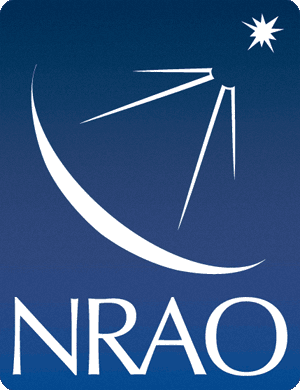
The NRAO is pleased to accept applications from institutes in North America to host a Community Day Event (CDE) between mid-January and mid-September 2020. CDEs are one- to two-day events designed in cooperation with host institutions during which NRAO staff give presentations on the capabilities of the Very Large Array (VLA), the Atacama Large Millimeter/submillimeter Array (ALMA), and the Very Long Baseline Array (VLBA), and tutorials on proposal preparation, observation preparation, and/or data reduction and data products.
The CDE agenda will be largely driven by the goals of the host institution and the expected participants. There will be no cost to the host institution. We ask only that you engage a minimum of 15 participants, each of whom is expected to bring a modern laptop capable of running the required software, and provide a sufficiently large meeting room with typical audiovisual capabilities (projector) and Wi-Fi. To reach this minimum, consider inviting colleagues from other institutions in your area.
To apply to host an NRAO CDE and for further information, please contact Emmanuel Momjian.
The CASA Software for Radio Astronomy

The Common Astronomy Software Applications (CASA) is the primary data processing software for the Atacama Large Millimeter/submillimeter Array (ALMA) and the Karl G. Jansky Very Large Array (VLA), and is often also used for calibrating and imaging data taken with other radio telescopes.
On 1 October, CASA released version 5.6.1 for general use, including a pipeline that has been scientifically validated for ALMA Cycle-7.
Recent CASA highlights include new single-dish tasks, improved widefield/wideband imaging, enhancements in automated masking, and improved polarization capabilities. CASA also offers increased Very Long Baseline Interferometry (VLBI) support through a collaboration with the Joint Institute for VLBI ERIC (JIVE). Moreover, the CASA team has been focusing significant efforts on reliability by adopting a new and more rigorous approach to testing, validating, and documenting CASA developments. More details can be found in the Release Notes of the official CASA Docs documentation.
The team is working hard on CASA 6, which will use a modular architecture and standard pip wheel installation to give users the flexibility of integrating CASA into their existing Python environments. Pip wheels for casa tasks and tools are currently available as beta versions from the public PyPI server. For information on installation and usage, the CASA team has created a Jupyter notebook. CASA will also continue to offer an all-inclusive monolithic version as a tar-file download, to replicate the appearance of previous CASA versions. The CASA team welcomes any feedback from users on this beta version of CASA 6.
Journal of Molecular Spectroscopy Issue Dedicated to Astronomical Spectroscopy
We like to draw your attention to a Call for submissions to a Virtual Special Issue (VSI) of the Journal of Molecular Spectroscopy that will focus on Astronomical Spectroscopy. This Special Issue is dedicated to Dr. Francis (Frank) J. Lovas for his pioneering work in laboratory and astronomical spectroscopy.
This VSI is particularly appropriate and timely because 2020 marks half a century since the advent of molecular astrophysics with discoveries of ammonia, water, formaldehyde, and carbon monoxide in rapid succession at radio frequencies. In this special issue of the Journal of Molecular Spectroscopy, we encourage the submission of original research papers that highlight the spectroscopic discoveries made possible by astronomical instrumentation, and associated laboratory and theoretical studies that are key drivers to this dynamic and rapidly growing field. Studies directly related to the work by Dr. Lovas are particularly encouraged.
All papers will be subject to the normal submission and refereeing process, and we will do our best to expedite reviewing of the manuscripts. To submit a manuscript please follow the online instructions.
Manuscript submission is now open! The deadline for manuscript submissions to be considered for this VSI is 31 January 2020.
The NRAO does provide page charge support for authors utilizing their instrumentation suite. Please visit the online NRAO Page Charge requirements for more information.
Please pass this along to any and all interested colleagues, and do not hesitate to contact us if you have any questions.
2018 NRAO Annual Report
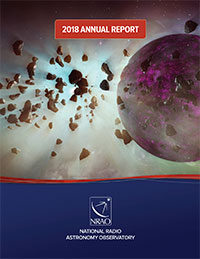
The NRAO Annual Report for calendar year 2018 describes the year’s science highlights and summarizes the numerous scientific, development, operations, and construction activities that were conducted across the Observatory from 1 January – 31 December 2018. The 2018 NRAO Annual Report can be accessed as a pdf download or for interactive on-line viewing.
Bracewell Sundial at the VLA

Miller Goss
Bracewell sundial at the VLA
[click to enlarge]
An article describing the design and construction of the Bracewell Sundial at the VLA has appeared in the September 2019 issue of Compendium, the journal of the North American Sundial Society. A 'Radio Sundial' for the Jansky Very Large Array in New Mexico, by Woody Sullivan, Miller Goss, and Anya Raj, includes appendices with information about the signers, high resolution images of the piers and their signatures, and other information.
The sundial, designed by Sullivan and dedicated in 2013, incorporates some of the concrete piers that originally held antennas for the 32 Dish Microwave Spectroheliograph that Ron Bracewell built at Stanford University and operated for two decades starting in the 1960s. Over a 20-year period, Bracewell accumulated about 250 "signatures" chiseled into the piers. Those who "signed" his piers included two Nobel Prize recipients, directors of observatories (radio and optical) from around the world, and many of the early pioneers of radio astronomy who established the field in the years following World War II. Bracewell's interferometer was abandoned in 1980. In 2012, ten of the concrete piers were sawed off and transported to the Very Large Array to become part of the sundial, a project supported by donations from the Friends of the Bracewell Observatory Association, Associated Universities, Inc., and the National Science Foundation. The piers, with their signatures, are now an integral part of the unique sundial. The sundial also has many connections to the history of radio astronomy and to other radio observatories, as well as allowing one to find the current location in the sky of three strong radio sources.
The NRAO / AUI Archives holds Bracewell's papers on radio astronomy, beginning with his time at the Commonwealth Scientific and Industrial Research Organisation and University of Cambridge in the 1940s, and including his long career at Stanford.
Recent Media Releases
|
New NSF Support Agreement for Next Generation Very Large Array |
|
|
NRAO’s Brett McGuire Part of Science News 10: Scientists to Watch |
|
|
From Cells To Galaxies And Beyond |
|
|
First Canadian ALMA Large Program to Investigate the Impact of Galaxy Environment on Star Formation |
|
|
Most Massive Neutron Star Ever Detected, Almost too Massive to Exist |
Career Opportunities
Astronomer (Tenure Track): The NRAO is seeking to appoint two new tenure-track scientists, one in each of the following focus areas: Atacama Large Millimeter/submillimeter Array (ALMA) science, and next generation Very Large Array (ngVLA) key science. The appointment for the ALMA science focus will be to the staff of the North American ALMA Science Center (NAASC) in Charlottesville, VA. The appointee will be expected to play a significant role in contributing to the science relevant to ALMA, including identifying and developing future scientific priorities for ngVLA and the NRAO, and building support for those priorities within the North American and international astronomy community. The appointment for the ngVLA key science area will be to the staff of NRAO’s New Mexico Operations department in Socorro, New Mexico. NRAO activities in New Mexico comprise the operation of the Very Large Array (VLA) and the Very Long Baseline Array (VLBA), and a variety of technical support functions for ALMA – North America, as well as being the center of the ngVLA design and development project. The appointee will be expected to contribute to the science relevant to the ngVLA, including identifying and developing future scientific priorities for ngVLA and the NRAO, and building support for those priorities within the North American and international astronomy community.
Assistant Director for Science Support & Research: The NRAO is seeking to recruit an Assistant Director for Science Support & Research (AD/SSR). Science Support & Research (SSR) is the Observatory-wide function supporting all scientific users of NRAO instruments, and overseeing the scientific research of the NRAO staff. This is an opportunity for an experienced scientist, with a track record of management and leadership, to take on an influential role in the senior management team of one of the world’s leading observatories. The appointee will help shape the mode of delivery of data to a global community of astronomers – the Science-Ready Data Products (SRDP) project – and will contribute to the definition and planning of the next generation Very Large Array. The AD/SSR is responsible for managing time allocation and the proposal handling processes for the Very Large Array and Very Long Baseline Array which are operated by NRAO, and for the Green Bank Telescope which is operated by the Green Bank Observatory (GBO). The AD/SSR is tasked with ensuring a uniform and effective interface for the NRAO and GBO user communities across all their telescopes and taking account of the ALMA review process which is the responsibility of the Joint ALMA Observatory. The AD/SSR manages staff responsible for common scientific services provided in support of our instruments, and coordinates outward-facing activities across all sites to minimize duplication and achieve optimal efficiency in support of all users of NRAO facilities.
Scientist/ Research Engineer (Open Rank): The Central Development Laboratory (CDL) at the National Radio Astronomy Observatory seeks a Research Engineer with expertise in novel millimeter-wave detectors, low temperature sensors, superconductors, and millimeter/submillimeter wavelength electronics for astrophysical observations. The position is at the CDL campus in Charlottesville, VA, and reports to the Director of the CDL. The selectee will be a member of the NRAO Scientific Staff and will lead the Observatory’s effort in developing the next-generation of millimeter wave/submillimeter wave detectors, to include leading our on-going work on Traveling-Wave Kinetic Inductance Parametric (TKIP) amplifiers. The selectee will also be a member of CDL’s millimeter/submillimeter receiver group working on a program of Superconductor-Insulator-Superconductor (SIS) junction-based designs in the development of low-noise millimeter/submillimeter wavelength instrumentation for use on the ALMA telescope and on other instruments around the world.
Jansky Fellowship: The NRAO Jansky Fellowship Program provides numerous opportunities for early career scientists and engineers to acquire a deep knowledge and understanding of the state-of-the-art in radio astronomy science and instrumentation to establish themselves as innovative, independent research scientists and engineers. Jansky Fellows are encouraged to develop research collaborations with NRAO scientific staff, scientists at U.S. universities, and their colleagues in the international astronomical or instrumentation community. An annual, multi-day NRAO Postdoctoral Symposium fosters collaboration between Jansky Fellows and the Observatory’s scientific staff. The deadline for 2020 Jansky Fellowship Program application materials, including letters of reference, is Friday, 1 November 2019 at 11:59 p.m. EDT. Award offers will be made starting in early January 2020. Fellowships normally begin in September 2020. Visit the Jansky Fellowship Program webpage for more information and instructions on how to apply. Questions or assistance with the application procedure, as well as requests for additional information on the Jansky Fellowship Program may be sent to Jansky2020@nrao.edu.
From the Archives
Ellen Bouton

[click to enlarge]
About this month's photo: Fifty years ago, in October 1969 during the depths of the Cold War, after more than a year of scientific, diplomatic, and bureaucratic planning (and reams of paperwork), and followed by innumerable technical and logistical problems, the first U.S.-U.S.S.R. Very Long Baseline Interferometry (VLBI) observations were made between the NRAO's 140-Foot Telescope in Green Bank and the Lebedev Physical Institute's 22-meter radio telescope in Crimea. Teams of NRAO and Soviet observers were on site for the hands-on observations. As described by Ken Kellermann in a series of articles in The Observer, a party was planned to follow the end of observing, "… but as the last hour approached the observing
room began to fill with spectators. When the last tape started the Russians produced, in their usual efficient manner, a round of glasses and several bottles of Cognac, and with toasts of Soviet-American friendship and cooperation, the first Green Bank-Crimea VLBI experiment was declared a success on the basis of having analyzed less than one half of one percent of the data." Celebrating in this photo are, standing left to right, Ivan Moiseyev (Director of the Crimean radio telescope), John Payne (NRAO), Victor Efanov (telescope staff). Seated is an unnamed member of the Crimean telescope staff. Photo by Ken Kellermann.
From the Archives is an ongoing series illustrating NRAO and U.S. radio astronomy history via images selected from our collections of individuals' and institutional papers. If readers have images they believe would be of interest to the Archives, please contact Ellen Bouton.

